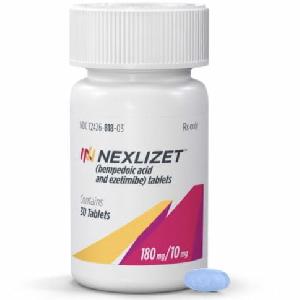Nexlizet Disease Interactions
There are 7 disease interactions with Nexlizet (bempedoic acid/ezetimibe).
- Liver disease
- Hepatic impairment
- Hyperuricemia
- Renal impairment
- Tendon injuries
- Myopathy/rhabdomyolysis
- Renal impairment
Ezetimibe (applies to Nexlizet) liver disease
Major Potential Hazard, High plausibility.
Ezetimibe is partially metabolized in the liver. After a single 10 mg dose, the mean area under the plasma concentration-time curve (AUC) for total ezetimibe was increased approximately 1.7-fold, 3- to 4-fold, and 5- to 6-fold, in patients with mild (Child-Pugh score 5 to 6), moderate (Child-Pugh score 7 to 9), and severe hepatic impairment (Child-Pugh score 10 to 15), respectively, compared to healthy subjects. Due to the unknown effects of increased exposure to ezetimibe in patients with moderate or severe hepatic impairment, therapy with ezetimibe is not recommended in these patients. The combination of ezetimibe with a statin is contraindicated in patients with active liver disease or unexplained persistent elevations in hepatic transaminase levels.
References
- (2002) "Product Information. Zetia (ezetimibe)." Schering-Plough Corporation
Bempedoic acid (applies to Nexlizet) hepatic impairment
Moderate Potential Hazard, Moderate plausibility. Applicable conditions: Liver Disease
Bempedoic acid has not been studied in patients with severe hepatic impairment (Child-Pugh C), therefore, caution is advised if used in these patients. No dosage adjustment is needed in patients with mild or moderate hepatic impairment (Child-Pugh A or B).
References
- (2020) "Product Information. Nexletol (bempedoic acid)." Esperion Therapeutics
Bempedoic acid (applies to Nexlizet) hyperuricemia
Moderate Potential Hazard, Moderate plausibility. Applicable conditions: Gout
Bempedoic acid can elevate serum uric acid. Caution is advised in patients with a history of gout. Assess uric acid levels periodically and monitor any signs or symptoms of hyperuricemia.
References
- (2020) "Product Information. Nexletol (bempedoic acid)." Esperion Therapeutics
Bempedoic acid (applies to Nexlizet) renal impairment
Moderate Potential Hazard, Moderate plausibility. Applicable conditions: Renal Dysfunction
There is limited experience with the use of bempedoic acid in patients with severe renal impairment, and the drug has not been studied in patients with end-stage renal disease (ESRD) receiving dialysis. Caution is advised if used in these patients.
References
- (2020) "Product Information. Nexletol (bempedoic acid)." Esperion Therapeutics
Bempedoic acid (applies to Nexlizet) tendon injuries
Moderate Potential Hazard, Moderate plausibility. Applicable conditions: Tendonitis, Renal Dysfunction
Bempedoic acid has been associated with an increased risk of tendon rupture or injury. Ruptures involving the rotator cuff, biceps, or Achilles tendon have been reported. Risk increases in patients over 60, those on corticosteroid or fluoroquinolone treatment, patients with renal failure, and patients with previous tendon disorders. Consider an alternative therapy in patients with a history of tendon disorders or rupture. Discontinue treatment if rupture of a tendon occurs or consider discontinuation if the patient experiences joint pain, swelling, or inflammation.
References
- (2020) "Product Information. Nexletol (bempedoic acid)." Esperion Therapeutics
Ezetimibe (applies to Nexlizet) myopathy/rhabdomyolysis
Moderate Potential Hazard, Moderate plausibility.
Myopathy and rhabdomyolysis are known adverse reactions to statins and other lipid-lowering drugs. In post-marketing experience with ezetimibe, cases of myopathy and rhabdomyolysis have been reported. Most patients who developed rhabdomyolysis were taking a statin prior to initiating ezetimibe. However, rhabdomyolysis has been reported with ezetimibe monotherapy and with the addition of ezetimibe to agents known to be associated with increased risk of rhabdomyolysis, such as fibrates. In the presence of muscle symptoms and a CPK level >10 × the ULN indicative of myopathy, ezetimibe and any statin or fibrate that the patient is taking concomitantly should be immediately discontinued if myopathy is diagnosed or suspected.
References
- (2002) "Product Information. Zetia (ezetimibe)." Schering-Plough Corporation
Ezetimibe (applies to Nexlizet) renal impairment
Moderate Potential Hazard, Moderate plausibility. Applicable conditions: Renal Dysfunction
No dosage adjustment of ezetimibe is necessary in patients with renal impairment. However, when ezetimibe therapy is given in combination with simvastatin in patients with moderate to severe renal impairment (estimated glomerular filtration rate <60 mL/min/1.73 m2), doses of simvastatin exceeding 20 mg should be used with caution and close monitoring is recommended.
References
- (2002) "Product Information. Zetia (ezetimibe)." Schering-Plough Corporation
Nexlizet drug interactions
There are 87 drug interactions with Nexlizet (bempedoic acid/ezetimibe).
More about Nexlizet (bempedoic acid/ezetimibe)
- Nexlizet consumer information
- Check interactions
- Compare alternatives
- Pricing & coupons
- Reviews (4)
- Drug images
- Side effects
- Dosage information
- Patient tips
- During pregnancy
- FDA approval history
- Drug class: antihyperlipidemic combinations
- En español
Related treatment guides
Drug Interaction Classification
| Highly clinically significant. Avoid combinations; the risk of the interaction outweighs the benefit. | |
| Moderately clinically significant. Usually avoid combinations; use it only under special circumstances. | |
| Minimally clinically significant. Minimize risk; assess risk and consider an alternative drug, take steps to circumvent the interaction risk and/or institute a monitoring plan. | |
| No interaction information available. |
Further information
Always consult your healthcare provider to ensure the information displayed on this page applies to your personal circumstances.


